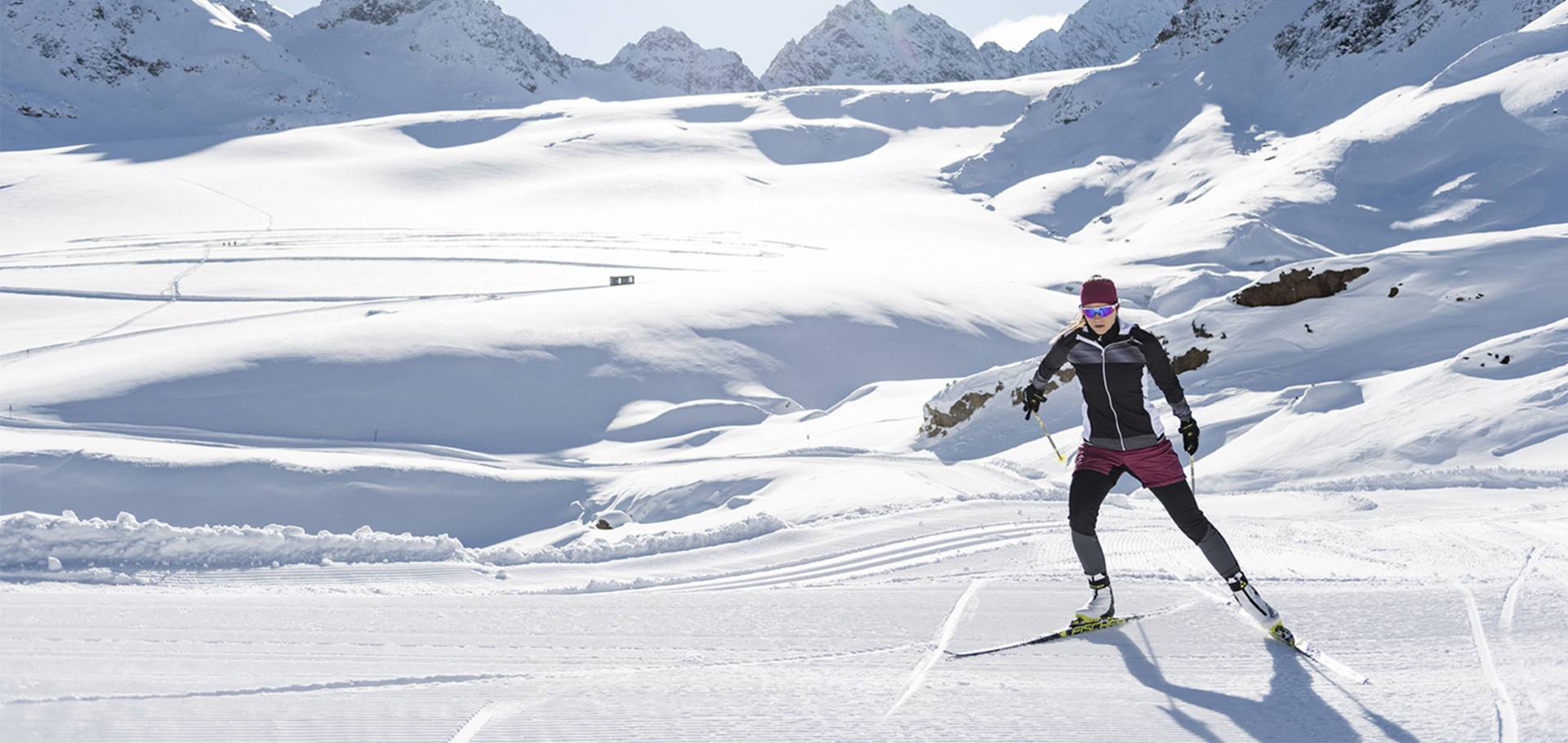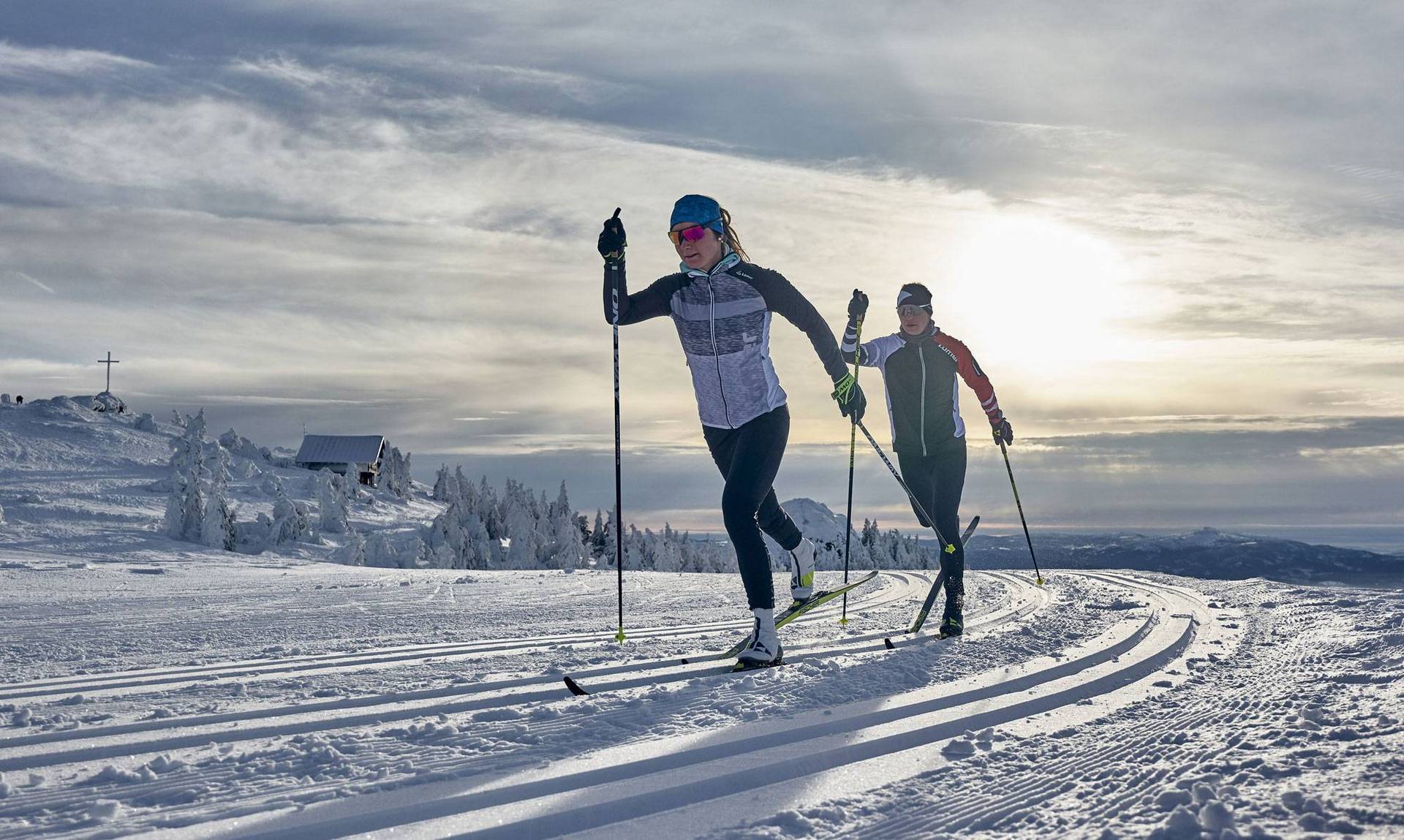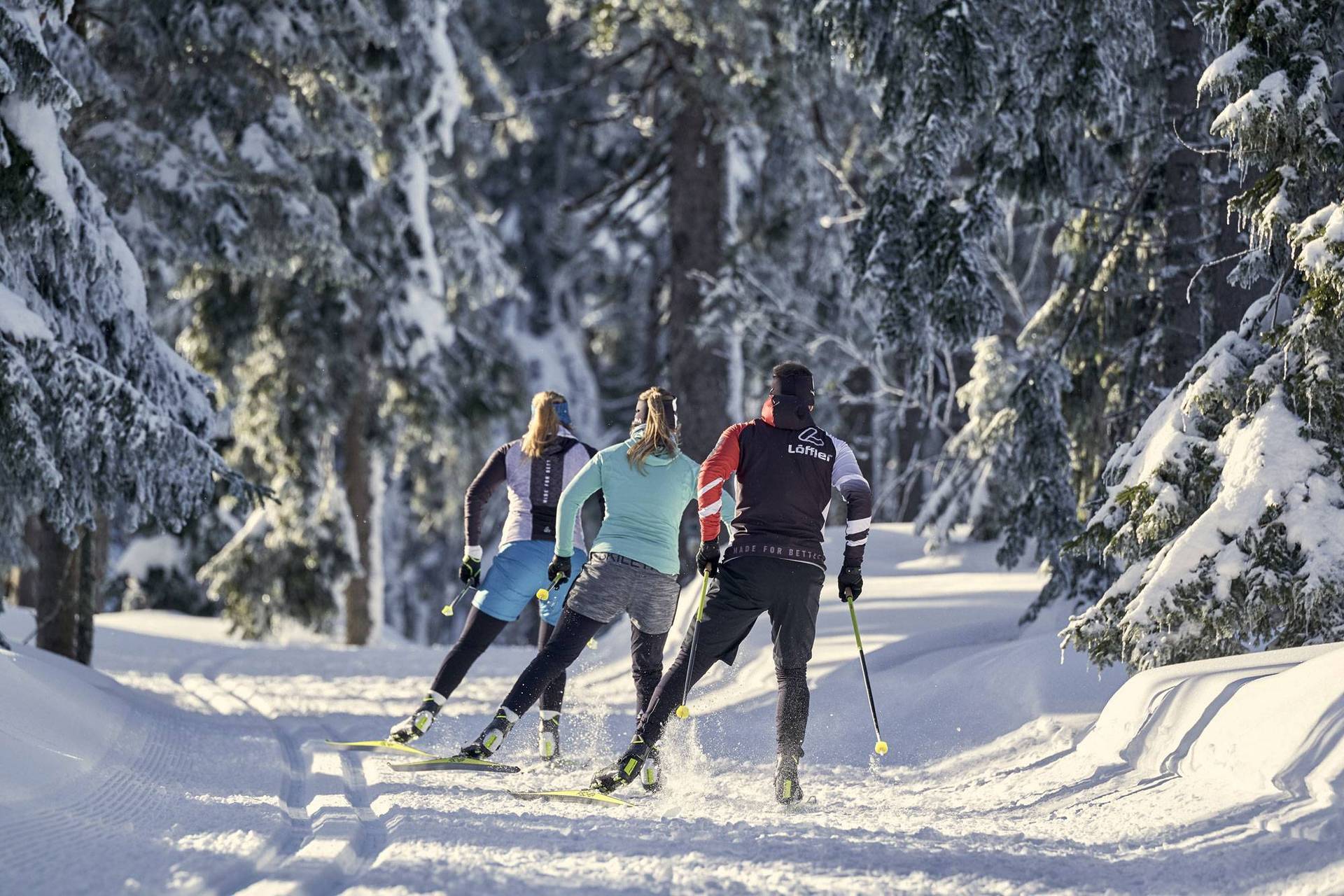
Learn to cross-country-ski
Tips & exercises for xc skiing beginners
Cross-Country

Since the Biathlon and Nordic Combined winter sport disciplines have regained their popularity, the enthusiasm for the two styles of cross-country skiing - "classic" and "skating" - has also risen enormously. Not only alpine skiing, but also cross-country skiing has developed into a highly fashionable winter trend sport in recent years.
When practised properly, it is one of the most effective winter sports. It promotes stamina, fitness, endurance and fat burning. Simultaneously, it is surely the most beautiful experience to be actively underway in almost untouched winter landscapes. Cross-country skiing is not just a more active winter sport than alpine skiing, but is also a lot more economical, since expensive ski passes are not required. If you want to learn to cross-country ski, we have a few helpful hints on "cross-country skiing for beginners", the right equipment and first exercises.
Classic or skating - Which technique would you like to learn to cross-country ski?
In classic cross-country skiing, you ski in specially-groomed cross-country ski tracks, diagonally pacing with parallel skis, while when skating you hold the feet and skis in a V position and push them forward from the side, similar to roller skating.

Classic cross-country skiing on the prepared cross-country ski trail

The skating technique of cross-country skiing
Which cross-country skiing technique is easier for beginners to learn?
Basically, the classic technique is better suited for cross-country skiing beginners as you will need less energy, it is easier to learn and requires less balance. In addition to the simpler technique of classic cross-country skiing, it is not as fast paced as skating. However, if you do a lot of roller and ice skating, you can also start with the skating technique, for which a lot more balance, strength and condition is required. Regardless of which technique you choose, we advise you to try either with rental equipment first and not to invest in your own expensive equipment straight away. This allows you to get a feel for which technique best suits you.
The right equipment for cross-country skiing
Regardless of the technique, you need the following equipment to learn how to cross-country ski: running pants, sport singlet, fleecy sport shirt, sport (running) jacket, gloves, scarf and a thin cap. Although this may seem insufficient for the wintry temperatures, you will quickly realise that it is more than sufficient, as you will soon “work up a sweat” practising this endurance sport.
Now to the cross-country skiing equipment which will differ slightly depending on the technique you choose. We recommend you hire this for your first few times. Take advantage of the cross-country ski hire service from Sport 2000 rent, where you will not only receive well maintained equipment, but also expert advice and equipment that is optimally suited to your height, weight and experience in cross-country skiing.
This includes:
- cross-country skis (length depending on technique)
- cross-country ski poles (length depending on technique)
- cross-country boots (snug fit)
The right equipment for classic cross-country skiing
The skis for classic cross-country skiing should principally be 20 cm longer than your body height. Additionally, you should choose a wider model, as you don´t need to balance so much. The length of the poles should be calculated as follows: Body height in cm x .84 = the length of the classic cross-country ski poles. When choosing boots you should wear special sport socks and make sure the boots fit snugly without chafing anywhere.
Cross-country skiing – the right equipment for skating
For the skating technique you will need cross-country skis that are 10 cm longer than your body height. Beginners who want to learn the skating technique should also choose wider skis, as they require less balance. Make sure you get a lightweight pair of cross-country skis, to avoid strain on your legs. The length of the poles for skating is calculated as follows: Body height in cm x .89 = the length of the skating cross-country ski poles. This means that the poles for skating should reach to your chin when you are standing on your skis.
Make sure the length of the ski poles fits, as, particularly in the beginning, they are your engine when your legwork is not yet down to a fine art. Simply ask at the local cross-country ski hire where professional staff will provide equipment suited to your needs – and you are ready to hit the trail.
The classic technique: cross-country skiing for beginners
Cross-country skiing began with the classic technique several hundred years ago. In 1843 the first cross-country competitions were held in Norway as endurance races. This technique has been refined over the years and has become a real national sport in many countries.
In classical cross-country skiing the main focus is a targeted use of the pole and the correct pushing of the feet as well as optimal gliding. There are two techniques:
- diagonal stride
- double pole
Diagonal stride
In the diagonal stride, arms and legs are used diagonally, as in Nordic Walking. In other words, you are pushing yourself off with the right foot and are simultaneously pushing yourself forward with the left arm using the pole. Through this you begin gliding on the left ski and then push yourself off with the left foot and the right pole.
Always try to glide for as long as possible while keeping your balance. This allows you to better and more effectively use your strength. The pole is always planted at the level of the ski's binding into the snow, the arm should be slightly bent, stretched forward and then pushed through backwards.
Double pole
Using the technique of double pole, all work is done by the upper torso and the arms. The skis are parallel in the track, both ski poles are planted parallel into the snow at the level of the bindings and you push yourself off, gliding forward. Lean forward in doing so, to harness more of your strength. Then plant the ski poles back into the snow ahead of you and push off again to continue the glide. This is by far the more demanding classic cross-country skiing technique and was established in addition to the diagonal stride.
The skating technique: cross-country skiing for beginners
The skating technique is a little faster and more challenging than the classic technique and requires more stamina, balance and technique, as you are not skiing in a prepared track but on a smooth, groomed snow surface. Moreover, you not only push off on your ski, but also glide on it, which means you have to learn the correct technique.
For skating there are considerably more techniques than for classic cross-country skiing. For beginners the following techniques are relevant at first:
- ice skating step
- jab technique
- double pole in combination with ice skating step
Exercises to learn the cross-country ski skating technique -
preparation for the ice skating technique
In order to get a feeling for the much narrower cross-country skis - compared to alpine skis - you should first of all put on just one cross-country ski and set aside your poles for the time being. In the beginning the leg technique is of paramount importance.
Practicing glide and balance
Gently push off with the ski-less foot in a forward motion, trying to keep your balance and glide. Try this a few times and then change to the other leg. If this works well you can go to the next exercise.
Practicing the push off
In order to be able to glide, you have to gain momentum. For this to happen, you must push off with one ski. As the cross-country skis are very slippery, it is important that you push simultaneously sideways and forward with the inner edge of the cross-country ski. Then you should try to glide on the other ski.
If you can already keep your balance and the push off works, you can now try the ice skating technique.
At the beginning, this is very difficult, so you should use a track of the classic cross-country trail for the exercise. Place your right leg in the left lane of the track (this is the ski which should now glide). Push off with the left leg, which forms a "V" shape with the other leg. Do this exercise for around 50 - 100 metres and then turn around to do the exercise on the other leg.
Ice skating technique
You should also start practicing the ice skating technique without poles. Position yourself on the skating track with your cross-country skis in a "V": ski tails together, ski tips apart. Now, starting with one leg, for example the left, you push forward. Doing this, try gliding on the right ski for as long as possible. Then, in an ice skating step, bring the left ski in (behind your feet, the left ski can overlap in the air), in a sliding movement put the left ski back on the ground and push off with the inside of the right cross-country ski. This will allow you to glide on the left ski.
Ice skating technique with double pole
Parallel to the ice skating technique, the poles can be used as follows: choose one leg and whenever this leg pushes off forward, plant the poles parallel to each other in front of you (just in front of the bindings), with almost straight arms and use the additional push of your arms to gain momentum and to increase the gliding phase on the other ski.
Jab technique
The jab technique is mainly used on ascents. The leading (jab) hand is selected towards the hill slope and extends further forward than the other hand. The skis are spread more widely apart on the hill. This prevents slipping back on the slope. Otherwise the technique is similar to the ice skating step in combination with the double pole.
Tip: Braking during cross-country skiing is similar to downhill skiing: using the snowplow technique!
Insider tips for the start of the season
If you want to improve your technique, or even want to take a cross-country skiing course, many winter sport regions and sport equipment retailers offer special cross-country skiing events to open the winter season. At these events, brand manufacturers are often present; you can test the latest models and participate in special cross-country courses at different levels. Or you book a special course or individual lessons.
Although learning the technique can be very challenging at the beginning, once the technique is learned, cross-country skiing is one of the most beautiful winter sports. On the expansive and remote cross-country ski trails you are often underway in unspoiltand remote winter landscapes, only interrupted by a cross country ski trail. Winter wonderland, peace and sport all in one - what could be more beautiful?